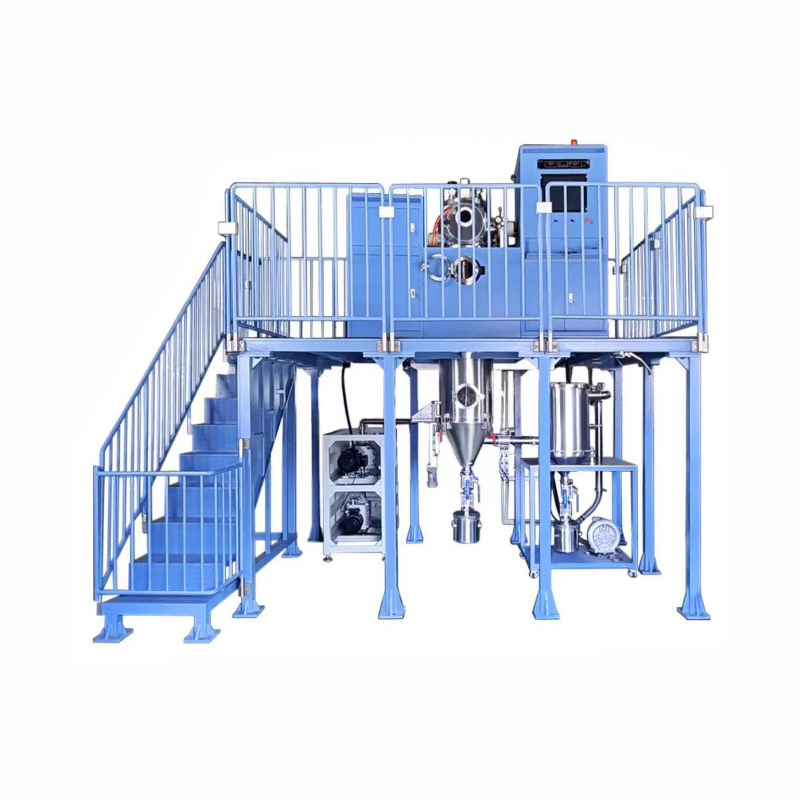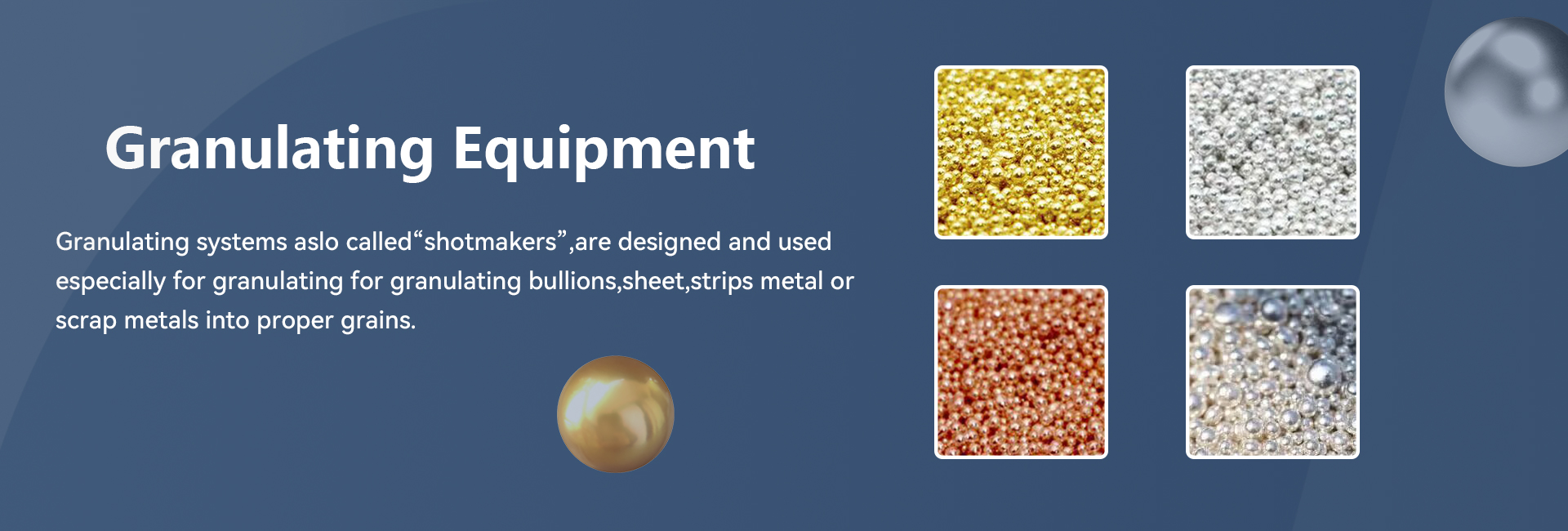Granulating Systems
Granulating systems also called “shotmakers”, are designed and used especially for granulating bullions, sheet, strips metal or scrap metals into proper grains. The granulating tanks are very easy to remove for clearing. Pull-out handle for easy removal of the tank insert. The optional equipment of a vacuum pressure casting machine or a continuous casting machine with a granulating tank is a solution for occasional granulating as well. Granulating tanks are available for all machines in the VPC series. The standard type granulating systems are equipped tank with four wheels which is easily moving in and out.
-

Metal Granulator Machine for Gold Silver Copper 4kg 6kg 8kg10kg15kg
1. With temperature control, accuracy up to ±1°C.
2. Ultra-human design, the operation is simpler than others.
3. Use imported Mitsubishi controller.
4. Silver Granulator with tempterature control (Gold Silver Grains Casting Machine, Silver Granulating Machine).
5. This machine adopts IGBT advanced heating technology, the casting effect is very good, the system is stable and safe, molten gold capacity is optional, and the granulated metal specification is optional.
6. The granulation speed is fast and no noise. Perfect advanced testing and protection functions make the whole machine safe and durable.
7. The machine has a split design and the body has more free space.
-

Platinum Granulating System Granulating Machine 10kg
Hasung Platinum Shot Maker Granulating Machine compared with similar products on the market, it has incomparable outstanding advantages in terms of performance, quality, appearance, etc., and enjoys a good reputation in the market.Hasung summarizes the defects of past products, and continuously improves them. The specifications of Hasung Platinum Shot Maker Granulating Machine can be customized according to your needs.
The main advantages of the new generations of shotmaker
Easy installation of the granulating tank with platform
High quality granulating performance
Ergonomically and perfectly balanced design for safe and easy handling
Optimized streaming behavior of the cooling water
Reliable separation of water and granules -

Vacuum Shot Maker for Gold Silver Copper 4kg 8kg 10kg
The design of this vacuum granulator system is based on the actual needs of the precious metal process by using modern high-tech induction heating technology.
The vacuum granulator is used to manufacture high quality and homogenous master grains for precious metals such as gold, silver, copper, and alloys, starting from raw material molten by Hasung induction heating in an inert gas protective atmosphere, then dropped into a water tank passing through a multi-hollowed crucible that acts as flow breaker.
The vacuum granulator adopts fully vacuum and inert gas melting and granulating, the machine can automatically stir in melting, electromagnetic stirring, and refrigeration in a closed + vacuum/inert gas protection melting chamber, so that the product has the characteristics of no oxidation, super low loss, no pores, no segregation in color, and beautiful appearance with uniform size.
This equipment uses Mitsubishi PLC program control system, SMC pneumatic and Panasonic servo motor drive and other well-known brand components at home and abroad.
-

High Vacuum Granulating System for Gold Silver Copper 20kg 50kg 100kg
High vacuum granulator granulates precious metal particles for casting bonding wire: gold, silver and copper, bonding wire is mainly used for semiconductor materials, photovoltaic welding materials, medical equipment, artificial intelligence machines.Also these high vacuum metal shotmakers are developed especially for granulating bullions, sheet metal, or scraps into proper grains. The granulating tanks are very easy to remove for cleaning. The HS-VGR High Vacuum Granulating Machines are available with crucible capacity from 20kg up to 100kg. The body materials are using 304 stainless steel which ensures the quality for long lifetime using, also with modular design to fulfill quality required.
Major applications:
1. Preparation of alloys out of gold and master alloy
2. Preparation of alloy components
3. Preparation of alloys from components
4. Cleaning up of already casted metal
5. Making metal grains for precious metal dealsThe VGR series was developed for the production of metal granules with a grain size of between 1.5 mm and 4mm. The systems are based on the Hasung granulation units, but all key components, particularly the jet system, are special developments.
The big capacity such as 100kg vacuum granulating system is optional to be equipped with individual Mitsubishi PLC Touch Panel control system.
The optional equipment of vacuum pressure or a continuous casting machine with a granulating tank is a suitable solution for occasional granulating. Granulating tanks are available for all machines in the VC series.
The main advantages of the new generations of shotmaker:
1. Easy installation of the granulating tank
2. Fast-changing between casting process and granulating
3. Ergonomically and perfectly balanced design for safe and easy handling
4. Optimized streaming behavior of the cooling water
5. Reliable separation of water and granules
6. The most powerful and efficient for precious metals refining groups.
7. Energy saving, speedy melting. -

Metal Granulating Machine for Gold Silver Copper Alloy 20kg 30kg 50kg 100kg 150kg
1. With temperature control, accuracy up to ±1°C.
2. Ultra-human design, the operation is simpler than others.
3. Use imported Mitsubishi controller.
4. Silver Granulator with tempterature control (Gold Silver Grains Casting Machine, Silver Granulating Machine).
5. This machine adopts IGBT advanced heating technology, the casting effect is very good, the system is stable and safe, molten gold capacity is optional, and the granulated metal specification is optional.
6. The granulation speed is fast and no noise. Perfect advanced testing and protection functions make the whole machine safe and durable.
7. The machine has a split design and the body has more free space.
-

Compact size Metal Granulator Granulating Equipment for Gold Silver
Small size metal shotmakers. With temperature control, accuracy up to ±1°C.
Ultra-human design, the operation is simpler than others.
Use imported Mitsubishi controller.This machine adopts Germany IGBT advanced heating technology, the casting effect is very good, the system is stable and safe, molten gold capacity is optional, and the granulated metal specification is optional. The granulation speed is fast and no noise. Perfect advanced testing and protection functions make the whole machine safe and durable. The machine has a split design and the body has more free space.
Using without air compressor, casting by manually mechanical opening stopper.
This GS Series granulating system is suitable for small capacity from 1kg to 8kg capacity(gold), it’s good for customers who has small space.
What is metal granulation?
Granulation (from Latin: granum = “grain”) is a goldsmith‘s technique whereby the surface of a jewel is decorated with small spheres of precious metal, named granules, according to a design pattern. The oldest archeological findings of jewels made with this technique were found in the royal tombs of Ur, in Mesopotamia and go back to 2500 B.C. From this area, the technique spread to Anatolia, in Syria, to Troy (2100 B.C.) and finally to Etruria (8th century B.C.). It was the gradual disappearance of the Etruscan culture between the third and second centuries B.C. that was responsible for the decline of granulation.1 The ancient Greeks employed granulation work as well, but it was the craftsmen of Etruria who became famous for this technique due to their mysterious deployment of fine powder granulation2 without apparent use of hard solder.
Granulation is probably the most mysterious and fascinating of ancient decorative techniques. Introduced by craftsmen Fenici and Greci to Etruria in 8th century BC, where the knowledge of metallurgy and the use of precious metals were already at an advanced stage, expert Etruscan goldsmiths made this technique their own to create works of art of unequaled complexity and beauty.
During the first half of the 1800’s several excavations were carried out in the vicinity of Rome (Cerveteri, Toscanella and Vulci) and Southern Russia (the Kertch and Taman peninsulas) which revealed ancient Etruscan and Greek jewelry. These jewels were decorated with granulation. The jewelry came to the attention of the Castellani Family of jewelers who were very involved in ancient jewelry research. The finds from the Etruscan burial sites attracted the most attention due to their use of extremely fine granules. Alessandro Castellani studied these artifacts in great detail in order to attempt to unravel their method of fabrication. It was not until the early 20th century, after Castellani’s death, that the puzzle of colloidal/eutectic soldering was finally solved.
Although the secret remained a mystery to the Castellanis and their contemporaries, the newly discovered Etruscan jewelry sparked an archaeological jewelry revival circa 1850’s. Goldsmithing techniques were discovered that enabled Castellani and others to faithfully reproduce some of the finest ancient jewelry ever excavated. Many of these techniques were quite different from those employed by the Etruscans yet still yielded a passable result. A number of these Archaeological Revival jewelry objects are now in important jewelry collections around the globe, along with their ancient counterparts.
GRANULES
The granules are made from the same alloy as the metal to which they will be applied. One method begins by rolling out a very thin sheet of metal and scissoring very narrow fringes along the edge. The fringe is trimmed off and the result is many small squares or platelets of metal. Another technique for creating grains uses very thin wire coiled around a thin mandrel, like a needle. The coil is then cut into very small jump rings. This creates very symmetrical rings that result in more evenly sized granules. The goal is to create many spheres the same size having a diameter of no larger than 1 mm.
The metal platelets or jump rings are coated in charcoal powder to prevent them from sticking together during firing. The bottom of a crucible is covered with a layer of charcoal and the metal bits are sprinkled on so they are as evenly spaced as possible. This is followed by a new layer of charcoal powder and more metal pieces until the crucible is about three-quarters full. The crucible is fired in a kiln or oven, and the precious metal pieces warp into small spheres at the melting temperature for their alloy. These newly created spheres are left to cool. Later they are cleaned in water or, if a soldering technique will be used, pickled in acid.
Granules of uneven sizes would not generate a pleasing design. Since it’s impossible for a goldsmith to create perfectly matched spheres of the exact same diameter, the granules must be sorted prior to use. A series of sieves are used to sort the granules.
How do you make gold shot?
Is the process of making gold shot just pouring off molten gold slowly into water after you've heated it? Or do you do it all at once? Whats the purpose of making gold shot instead of ingots ect.
Gold shot is not created by pouring from the lip of a container. It must be discharged through a nozzle. You can make a simple one by drilling a small hole (1/8") in the bottom of a melting dish, which would then be mounted over your container of water, with a torch playing on the dish, around the hole. That prevents the gold from freezing in the dish when it is transferred from the melting dish in which the gold powder is melted. For reasons that have always been hard for me to understand, that forms shot, instead of cornflakes.
Shot is preferred by those that use gold, for it makes weighing out the desired amount easy. Wise goldsmiths don't melt a lot of gold at one time, otherwise it could lead to defective castings (gas inclusions).
By melting only the amount that is needed, the small amount left over (the sprue) can be melted with the next batch, assuring that re-melted gold doesn't accumulate.
The problem with melting gold time and again is that the base metal (typically copper, but not restricted to copper) oxidizes and begins creating gas that accumulates in tiny pockets in castings. Most every jeweler that does casting has had that experience, and often accounts for why they won't, or don't prefer to use gold that has been used previously.












